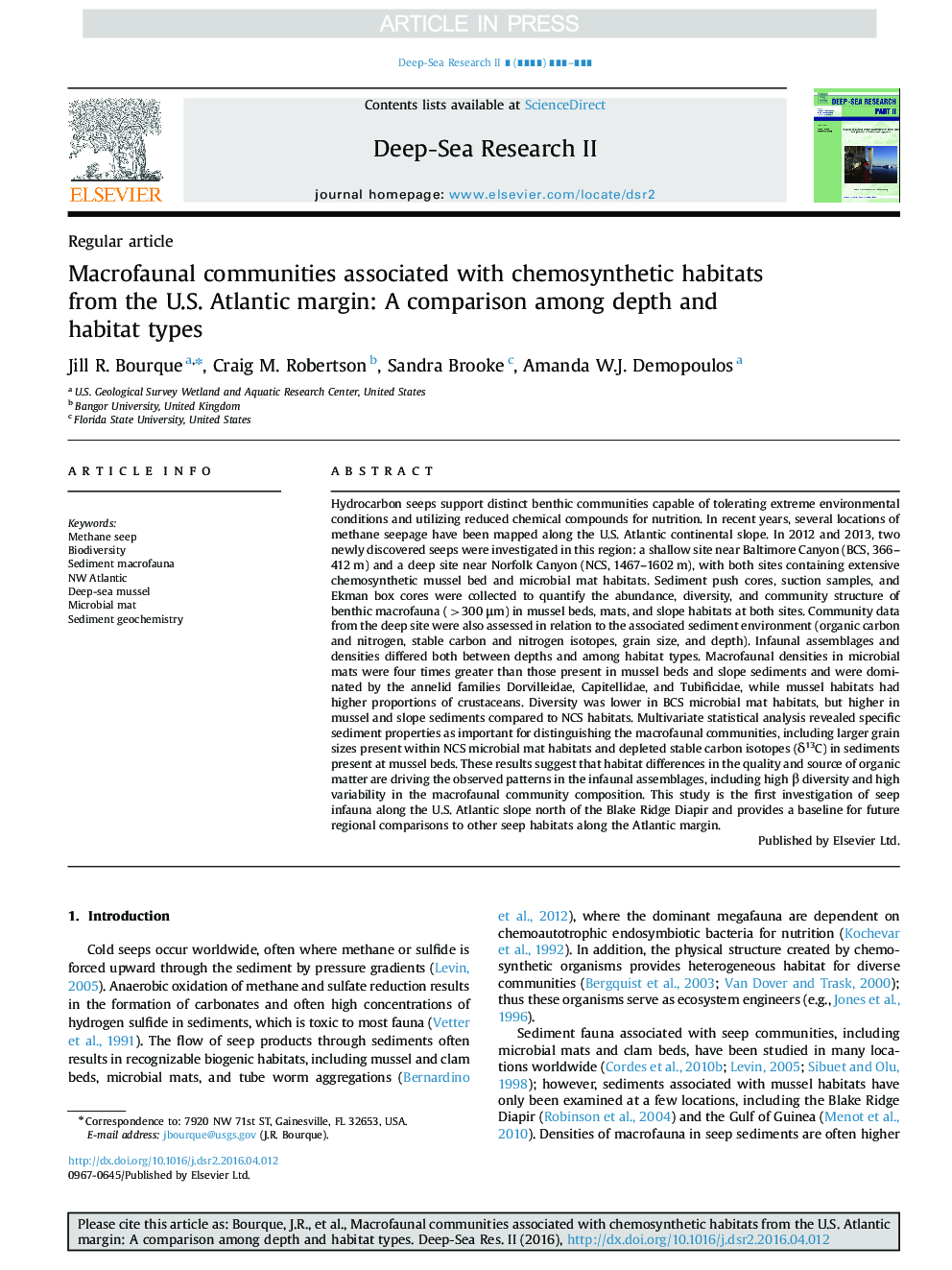| کد مقاله | کد نشریه | سال انتشار | مقاله انگلیسی | نسخه تمام متن |
|---|---|---|---|---|
| 5764817 | 1626405 | 2017 | 14 صفحه PDF | دانلود رایگان |
عنوان انگلیسی مقاله ISI
Macrofaunal communities associated with chemosynthetic habitats from the U.S. Atlantic margin: A comparison among depth and habitat types
ترجمه فارسی عنوان
جوامع مکروفیون در ارتباط با زیستگاههای شیمیایی زیستگاه از حاشیه آتلانتیک ایالات متحده: مقایسهای بین عمق و نوع زیستگاه
دانلود مقاله + سفارش ترجمه
دانلود مقاله ISI انگلیسی
رایگان برای ایرانیان
کلمات کلیدی
موضوعات مرتبط
مهندسی و علوم پایه
علوم زمین و سیارات
زمین شناسی
چکیده انگلیسی
Hydrocarbon seeps support distinct benthic communities capable of tolerating extreme environmental conditions and utilizing reduced chemical compounds for nutrition. In recent years, several locations of methane seepage have been mapped along the U.S. Atlantic continental slope. In 2012 and 2013, two newly discovered seeps were investigated in this region: a shallow site near Baltimore Canyon (BCS, 366-412 m) and a deep site near Norfolk Canyon (NCS, 1467-1602 m), with both sites containing extensive chemosynthetic mussel bed and microbial mat habitats. Sediment push cores, suction samples, and Ekman box cores were collected to quantify the abundance, diversity, and community structure of benthic macrofauna (>300 μm) in mussel beds, mats, and slope habitats at both sites. Community data from the deep site were also assessed in relation to the associated sediment environment (organic carbon and nitrogen, stable carbon and nitrogen isotopes, grain size, and depth). Infaunal assemblages and densities differed both between depths and among habitat types. Macrofaunal densities in microbial mats were four times greater than those present in mussel beds and slope sediments and were dominated by the annelid families Dorvilleidae, Capitellidae, and Tubificidae, while mussel habitats had higher proportions of crustaceans. Diversity was lower in BCS microbial mat habitats, but higher in mussel and slope sediments compared to NCS habitats. Multivariate statistical analysis revealed specific sediment properties as important for distinguishing the macrofaunal communities, including larger grain sizes present within NCS microbial mat habitats and depleted stable carbon isotopes (δ13C) in sediments present at mussel beds. These results suggest that habitat differences in the quality and source of organic matter are driving the observed patterns in the infaunal assemblages, including high β diversity and high variability in the macrofaunal community composition. This study is the first investigation of seep infauna along the U.S. Atlantic slope north of the Blake Ridge Diapir and provides a baseline for future regional comparisons to other seep habitats along the Atlantic margin.
ناشر
Database: Elsevier - ScienceDirect (ساینس دایرکت)
Journal: Deep Sea Research Part II: Topical Studies in Oceanography - Volume 137, March 2017, Pages 42-55
Journal: Deep Sea Research Part II: Topical Studies in Oceanography - Volume 137, March 2017, Pages 42-55
نویسندگان
Jill R. Bourque, Craig M. Robertson, Sandra Brooke, Amanda W.J. Demopoulos,
